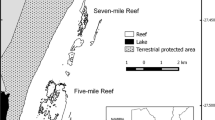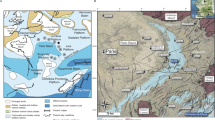Summary
Benthic coral reef communities were investigated on the Sanganeb-Atoll, 28 km off the coast of Port Sudan (Sudan, central Red Sea). Four test areas (5×5 m) were selected and marked in approx. 10 m depth along a transect running in SSW-NNE direction over the atoll and were mapped in 1980 and 1991. Detailed photographs were used for in situ verification of taxonomic composition of communities (comprising some 135 cnidarian species) and transferred to scale 1∶10 maps, used for the quantitative analyses of coral communities in the test areas. Shares of inanimate (unoccupied) substrate were 42–60% of the total test areas in 1991 (i.e. slightly larger than at the 1980 census). The living cover was mainly composed of scleractinian and alcyonacean species. Coral communities were analysed on the species level with regard to taxonomic composition, areal coverage, biophysiographic zonation, and changes in community structures during the investigation period of 11 years. The analyses revealed a general constancy in the overall composition and distribution of benthic taxa which reflect the different abiotic conditions along the transect across the leeward and windward sides of the atoll. However, the detailed view on species recruitment, growth, decrease and disappearance on the base of a decadal time span allows to detect life history traints of stony and soft corals and their significance for the dynamics of the respective communities. Especially soft corals (predominating in the two leeward test quadrats) exhibit various strategies to colonize and occupy space. Their presence, however, is hardly to be detected from the fossil record (except for spiculite of some Sinularia spp.). Exemplarity, single colonies' fates were reconstructed and extrapolated. Based on the data of species recruitment and disappearance a time estimate for development and turnover of reef communities is provided. Species turnover rates were calculated as approx. 15 species/10 years (Trel=2.63%/year) with estimated median community turnover periods of 416 (323–755) years from recruitment rates, or 338 (219–526) years from clearing rates.
Data reference: This study is based on extensive datasets compiled in five appendices (referred to as “App.” in the text) which can be viewed and/or downloaded from the internet site at: www.meeresmuseum.de/sciencedata/facies-sanganeb.pdf.
Similar content being viewed by others
References
Achituv, Y. and Benayahu, Y. (1990): Rolyp dimorphism and functional, sequential hermaphroditism in the soft coral Heteroxenia fuscescens (Octocorallis).—Mar. Ecol. Prog. Ser., 64, 263–269.
Alderslade, P. (2000): Four new genera of soft corals (Coelenterata: Octocorallia), with notes on the classification of some established taxa.—Zool. Med. Leiden, 74, 237–249.
— (2001): Six new genera and six new species of soft coral, and some proposed familial and subfamilial changes within the Alcyonacea (Coelenterata: Octocorallia).—Bull. Biol. Soc. Wash., 10, 15–65.
Aronson, R.B., Macintyre, I.G., Precht, W.F., Murdoch, T.J.T., and Wapnick, Ch.M. (2002): The expanding scale of species turnover events on coral reefs in Belize.—Ecol. Monogr., 72, 233–249.
Benayahu, Y. and Loya, Y., (1984): Substratum preferences and planulae settling of two Red Sea alcyonaceans: Xenia macrospiculata Gohar, and Parerythropodium fulvum fulvum (Forskal)—J. Exp. Mar. Biol. Ecol., 83, 249–261.
—— (1985): Settlement and recruitment of a soft coral: Why is Xenia macrospiculata a successful colonizer?—Bull. Mar. Sci., 36, 177–188.
—— (1987): Long-term recruitment of soft-corals (Octocorallia: Alcyonacea) on artificial substrata at Eilat (Red Sea).—Mar. Ecol. Prog. Ser., 38, 161–167.
Bohnsack, J.A. (1979): Photographic quantitative sampling of hard-bottom benthic communities.—Bull. Mar. Sci., 29, 242–252.
Brachert, T.C. and Dullo, W.-Ch. (1991): Laminar micrite crusts and associated foreslope processes, Red Sea.—J. Sedim. Petrol., 61, 354–363.
Buddemeier, R.W., (1994): Symbiosis, calcification, and environmental interactions.—Bulletin del'Institut oceanographique, Monaco, no special, 13, 119–131.
Connell, J.H. (1973): Population ecology of reef-building corals. —In: Jones O.A. and Endean R. (eds.): Biology and Geology of Coral Reefs.—2, 217–245, London (Academic Press).
Connell, J.H., Hughes, T.P. and Wallace, C.C. (1997): A 30-year study of coral abundance, recruitment, and disturbance at several scales in space and time.—Ecol. Monogr., 67, 461–488.
Dahan, M. and Benayahu, Y. (1997): Clonal propagation by the azooxanthellate octocoral Dendronephthya hemprichi.—Coral Reefs, 16, 5–12.
Done, T.J. (1992): Constancy and Change in some Great Barrier Reef Coral Communities: 1980–1990.—Am. Zool., 32, 655–662.
— (1999): Coral community adaptability to environmental change at the scales of regions, reefs and reef zones.—Am. Zool., 39, 66–79.
Dubinsky, Z. and Stambler, N. (1996): Marine pollution and coral reefs.—Global Change Biology, 2, 511–526.
Dustan, P. and Halas, J.C. (1987): Changes in the reef-coral community of Carysfort Reef, Key Largo, Florida: 1974 to 1982.—Coral Reefs, 6, 91–106.
Endean, R. and Cameron, A.M. (1990): Trends and new perspectives in coral-reef ecology.—In: Dubinsky, Z. (ed.): Coral Reefs.—469–492. Amsterdam (Elsevier).
Fabricius, K.E. (1995): Slow population turnover in the soft-coral genera Sinularia and Sarcophyton in mid- and outershelf reefs of the Great Barrier Reef.—Mar. Ecol. Prog. Ser., 126, 145–152.
Gleason, M.G. (1993): Effects of disturbance on coral communities: bleaching in Moorea, French Polynesia.—Coral Reefs, 12, 193–201.
Guilcher, A. (1988): A heretofore neglected type of coral reef: The ridge reef. Morphology and origin.—Proc. 6th Int. Coral Reef Symp, Townsville, 3, 399–402.
Guzman, H.M., Jackson, J.B.C. and Weil, E. (1991): Short-term ecological consequences of a major oil spill on Panamanian subtidal reef corals.—Coral Reefs 10, 1–12.
Handbuch für das Rote Meer und den Persischen Golf, (1988). Nr 2034, 7. Aufl.—493 pp., Deutsches Hydrographisches Institut (Hamburg).
Hartshorn, G.S. (1978): Tree fall and tropical forest dynamics.— In: Tomlinson, P.B. and Zimmermann, M.H. (eds). Tropical Trees as Living Systems—617–638, London (Cambridge University Press).
Heiss, A.G. (1994): Coral Reefs in the Red Sea: Growth, production and stable isotopes.—GEOMAR Report No. 32, 1–137.
Highsmith, R.C., (1992): Reproduction by fragmentation in, corals. —Mar. Ecol. Prog. Ser., 7, 207–226.
Hopley, D. (1997): Coral reefs and climate change.—WWF Climate Change Cmapaign, Report, Washington, 46 pp.
Hughes, T.P. (1994): Catastrophes, Phase Shifts, and Large-Scale Degradation of a Caribbean Coral Reef.—Science, 265, 1547–1551.
Jokiel, P.L., Hunter, C.L., Taguchi, L. and Watarai, L. (1993): Ecological impact of a freshwater “reef-kill” in Kaneohe Bay, Oahu, Hawaii.—Coral Reefs, 12, 177–184.
Karlson, R.H. (1999): Dynamics of coral communities.—250 pp., Dordrecht (Kluwer)
Karlson, R.H. and Hurd, L.E., (1993): Disturbance, coral reef communities and changing ecological paradigms.—Coral Reefs, 12, 117–125.
Klunzinger, C.B. (1879): Die Korallthiere des Rothen Meeres. 2: Die Steinkorallen. 1. Die Madreporaceen und Oculinaceen.— 88 pp., Berlin (Gutmann)
Loch, K., Loch, W., Schuhmacher, H. and See, W.R. (2002): Coral recruitment and regeneration on a Maldivian reef 21 months after the coral bleaching event, of 1998.—Mar. Ecol., 23, 219–236.
Massel, S.R. and Done, T.J. (1993): Effects of cyclone waves on masive coral assemblages on the Great Barrier Reef: meteorology, hydrodynamics and demography.—Coral Reefs, 12, 153–166.
McClanahan, T.R., Muthiga, N.A. (1998): An ecological shift in a remote coral atoll of Belize over 25 years.—Envir. Conserv., 22, 122–130.
McConnaughey, T.A., Whelan, J.F. (1997): Calcification generates protons for nutrient and bicarbonate uptake.—Elsevier Science B.V., Earth-Science Reviews, 42, 95–117.
Mergner, H. and Schuhmacher, H. (1981): Quantitative Analyse der Korallenbesiedlung eines Vorriffareals bei Aqaba (Rotes Meer).—Helgoländer Meeresunters., 34, 337–354.
—— (1985): Quantitative Analyse von Korallengemeinschaften des Sanganeb-Atolls (mittleres Rotes Meer)—I. Die Besiedlungsstruktur hydrodynamisch unterschiedlich exponierter Außen- und Innenriffe.—Helgoländer Meeresunters., 39, 375–417.
Mergner, H., Schuhmacher, H. and Kroll, D. (1994): Longterm changes in the coral community of a fore reef area at Aqaba (Red Sea): 1976–1989.—Proc. 7th Int. Coral Reef Symp., Guam, 1, 104–113.
Pichon, M. (1978): Problems of measuring and mapping coral colonies.—In: Stoddart, D.R. and Johannes, R.E. (eds.), Coral reefs: research methods.—219–230, Paris (UNESCO).
Porter, J.W., Woodley, J.D., Smith, G.J., Neigel, J.E., Battey, J.F., and Dallmeyer, D.G. (1981): Population trends among Jamaican reef corals.—Nature, 294, 249–250.
Porter, J.W., Meier, O.W. (1992). Quantification of Loss and Change in Floridian Reef Coral Populations.—Amer. Zool., 32, 625–640.
Reinicke, G.B. (1995): Beiträge zur Systematik und Ökologie der Xeniidae (Octocorallia, Alcyonacea) des Roten Meeres. Essener Ökologische Schriften, 6, 192 pp., Magdeburg (Westarp Wissenschaften)
— (1997): Xeniidae (Coelenterata: Octocorallia) of the Red Sea, with descriptions of six new species of Xenia.—Fauna of Saudi Arabia, 16, 5–62.
Reinicke, G.B. and Schuhmacher, H. (1996): Significance of different trrits of soft coral assemblages (Octocorallia, Alcyoniina) in benthic reef communities of the Red Sea.— Göttinger Arb. Geol. Paläont., Sb2, 77–84.
Richmond, R.H. (1987): Energetics, competency, and long-distance dispersal of planula larvae of the coral Pillopora damicornis.—Mar. Biol., 93, 527–533.
Riegl, B., Velimirov, B. (1994): The structure of coral communities at Hurghada in the northern Red Sea.—Mar. Ecol., 15, 213–231.
Rogers, C.S. (1993): Hurricanes on coral reefs: the intermediate disturbance hypothesis revisited.—Coral Reefs, 12, 127–137.
Rosen, B.R. (1981): The tropical high diversity enigma—the corals' eye view.—In: Forey, P.L. (ed.): Chance, Change and Challenge—The evolving biosphere.—103–129, Cambridge (University Press).
Scheer, G. (1978): Application of phytosociologic methods.—In: Stoddard, D.R. and Johannes, R.E. (eds.): Coral reefs: research methods.—175–196, Paris (UNESCO).
Scheer, G. and Pillai, C.S.G. (1983): Report on the stony corals from the Red Sea.—Zoologica, Stuttgart, 133, 1–198.
Schoener, T.W. (1983): Rate of species turnover decreases from lower to higher organisms: a review of the data.—Oikos, 41, 372–377.
Schuhmacher, H. (1974): On the conditions accompanying the first settlement of corals on artificial reefs with special reference to the influence of grazing sea urchins (Eilat, Red Sea).—Proc. 2nd Int. Symp. coral Reefs, Australia 1973, 1, 257–267.
— (1989): Development of coral communities on artificial reef types over 20 years (Eilat, Red Sea).—Proc. 6th Int. Coral Reef Symp., Townsville 1988, 3, 379–384.
— (1997): Soft corals as reef builders.—Proc. 8th Int. Coral Reef Symp., Panama 1996, 1, 499–502.
Schuhmacher, H., Kiene, W. and Dullo, W.-Ch. (1995): Factors controlling Holocene reef growth: an interdisciplinary approach. —Facies, 32, 145–188.
Schuhmacher, H. and Mergner, H. (1985): Quantitative Analyse von Korallengemeinschaften des Sanganeb-Atolls (mittleres Rotes Meer).—II. Vergleich mit einem Riffareal bei Aqaba (nördliches Rotes Meer) am Nordrande des indopazifischen Riffgürtels.—Helgoländer Meeresunters., 39, 419–440.
Sheppard, C.R.C. (1985): Unoccupied substrate in the central Great Barrier Reef: role of coral interactions.—Mar. Ecol. Prog. Ser., 25: 259–268.
Sheppard, C.R.C. and Sheppard, A.L.S. (1991): Corals and coral communities of Arabia.—Fauna of Saudi Arabia, 12, 1–170.
Sheppard, C.R.C., Price, A. and Roberts, C. (1992): Marine ecology of the Arabian region.—359 pp. London (Academic Press).
Smith, T.J. (1992): Forest structure.—In: Robertson, A.I., and Alongi, D.M. (eds.): Coastal and estruarine studies. Tropical mangrove ecosystems.—101–136, Washington D.C. (American Geophysical Union).
Stoddart, D.R. (1969): Ecology and morphology of recent coral reefs.—Biol. Rev., 44, 433–498.
Van Treeck, P., Schuhmacher, H. and Paster, M. (1996): Grazing and bioerosion by herbivorous fishes—key processes structuring coral reef communities.—In: Reitner, J., Neuweiler, F. and Gunkel, F. (eds.): Global and regional controls on biogenic sedimentation.—I. Reef Evolution. Research Reports. —Göttinger Arb. Geol. Paläont., Sb2, 133–137.
Veron, J.E.N. (2000): Corals of the world, 3 Volumes.—Townsville, Australian Institute of Marine Science.
Weinberg, S. (1981). A comparison of coral reef survey methods. —Bijdr Dierk., 51, 199–218.
Author information
Authors and Affiliations
Additional information
“If the biota, in the course of aeons, has built something we like but do not understand, then who but a fool would disregard seemingly useless parts? To keep every cog and wheel is the first precaution of intelligent tinkering.” Aldo Leopold, A Sand Country Almanac, 1949
Rights and permissions
About this article
Cite this article
Reinicke, G.B., Kroll, D.K. & Schuhmacher, H. Patterns and changes of reef-coral communities at the Sanganeb-Atoll (Sudan, central Red Sea): 1980 to 1991. Facies 49, 271–297 (2003). https://doi.org/10.1007/s10347-003-0035-9
Received:
Issue Date:
DOI: https://doi.org/10.1007/s10347-003-0035-9




